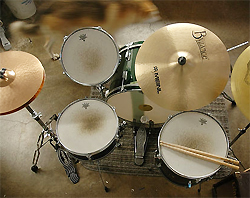
Time stretching
When I started out drum editing I was in love with Elastic Audio, a feature of Pro Tools 7.4. I could quantize drums quickly without a lot of effort. What was cool was that the audio would stretch proportionally between each edit.
But often there would be glitches or things would sound weird. A bunch of time was required to fine tune. Sometimes it was good enough, sometimes it was immediately obvious that the quality just wasn’t there, and it didn’t get any better in Pro Tools 8. The same thing applies to Logic’s “Flex Time.”
Automatic slicing and quantizing
The world standard tool for drum editing is Beat Detective in Pro Tools and for good reason. It is a powerful editing tool that can analyze the transients on all or individual tracks, slice before all transients simultaneously, lock the transients to the gridline, fill gaps and crossfade all edits in just a few clicks.
Some editors do the whole song at once, some do a section or a few bars at a time. Sounds like a great thing, well it’s far from perfect.
My primary complaint was that Pro Tools is extremely hard on your system due to their “fade files” which are tiny wave files for every single edit. With my drum editing sessions having 8,000 to 15,000 fade files, the hard drive just can’t keep up. After the bulk of the editing was finished making the fine tuning edits would take a long time because the system becomes very unresponsive trying to keep track of all these files. I dealt with this for a few years before moving to REAPER for drum editing.
Manual slicing and aligning
Manual slicing and alignment is my preference and it has been absolutely worth the extra time and effort. In a lot of cases I’ve found it to be faster that using Beat Detective. There is far less error correction required because I ensure every edit is correct from the start.
The downside to this method is that it it’s entirely editing with your eyes and mouse, listening as you go slows you down by a significant amount and I’ve found it best to save the listening to the end.
The key reasons I prefer the manual method is that, I select where to cut, I decide what the transient is, and I decide where the transient should be. By doing this by eye and ear rather than via algorithm I get the edits exactly how I like the first time.
Why I edit with REAPER now
After several years of editing with Beat Detective in Pro Tools I got fed up with the inefficiency. I saw a colleague editing drums in REAPER and once I tried it I was hooked. REAPER is a super light-weight but full featured DAW.
Some of the editing specific advantages are:
—No fade files. No slowdown from making tens of thousands of edits
—Automatic cross fade for every edit
—The mouse can be armed to split the regions on every click
—Audio within the regions can be moved without changing the region boundaries
—Customizable key commands and build-your-own actions
Drum editing isn’t for everyone
Honestly, drum editing is pretty boring and monotonous. It can also take a pretty big time commitment. Learning to do it well certainly was. Its not a skill you can pickup in a weekend, you can’t read a book or watch a video and learn all you need to know. It takes months, and you may hate every grueling hour of it.
If you try it, hate it, or would just rather focus on other aspects of music making, you can outsource this work to an editor like me for less than the cost of an hour in a pro studio. I also guarantee my work is better than that of a typical pro studio which usually delegates drum editing to unpaid interns with little to no experience.
Jon Tidey is a Producer/Engineer who runs his own studio, EPIC Sounds, and enjoys writing about audio on his blog AudioGeekZine.com. To comment and ask questions about this article go here.
